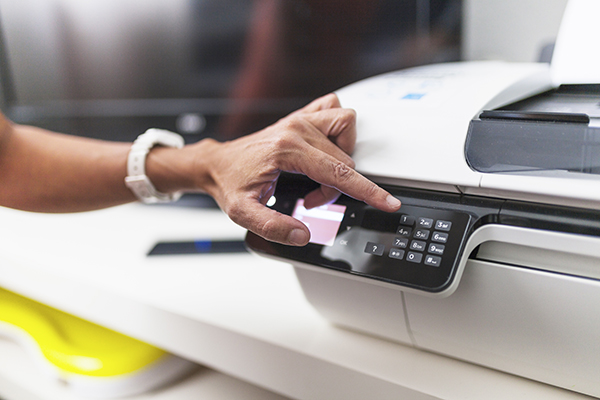
Generally, it seems like you discover your printer isn’t working correctly when it’s time to print an important document. In most cases, though, printer issues can be resolved quickly.
First, make sure your printer is plugged in and turned on. If your printer is wired, meaning it plugs into your computer directly with a cord and USB, ensure it’s connected. If your printer is wireless, do one of the following:
- Make sure the wireless option is turned on and available. There is often a wireless icon that appears on the printer when the wireless connection option is available.
- Run a connectivity test. Check the instructions that came with your printer or the manufacturer’s website.
You can also download the printing troubleshooter from support.microsoft.com. Using the troubleshooter can fix problems that occur when connecting or installing a printer.
If the troubleshooter isn’t helpful, your printer’s drivers may need to be updated. Most printers require software to work and occasionally that software needs an update to work properly with your operating system. Drivers can also become damaged due to power outages, viruses or other issues.
According to Microsoft, there are three ways to get the latest driver.
Use Windows Update. Windows Update might have an updated version of your printer driver. To update your drivers using Windows Update follow these steps:
- Press and hold (or right-click) the Start button, then select Device Manager. You might be asked for an admin password or to confirm your choice.
- Expand Printers, find your printer in the list, press and hold (or right-click) it, and then select Update driver.
- Select Search automatically for updated driver software.
- Install software from the printer manufacturer. If your printer came with a disc, that disc might contain software that installs a driver for the printer.
- Download and install the driver yourself.If Windows Update can’t find a driver for your printer, and the printer didn’t come with software that installs a driver, check the manufacturer’s website. Driver updates are often available in the support section of such websites. Locate and download the latest driver for your printer, then follow the driver installation instructions on the website.
Most drivers are self-installing—after you download them, you usually double-tap (or double-click) the file to begin the installation. If you download a driver that isn’t self-installing, follow these steps to install it:
- Press and hold (or right-click) the Startbutton, then select Device Manager. You might be asked for an admin password or to confirm your choice.
- Expand Printers, find your printer in the list, press and hold (or right-click) it, and then select Update driver.
- Select Browse my computer for driver software,browse to the location where you downloaded the driver software, and then select Next. You might be asked for an admin password or to confirm your choice.
If these steps don’t work, try removing and reinstalling the driver. This may be necessary to ensure that damaged or corrupted drivers are completely replaced. Follow these steps remove the old driver:
- Disconnect your printer’s USB cable from your PC.
- Select the Start button, then select Settings > Devices > Printers and Scanners.
- Find the printer in the list under Printers & scanners for the printer. If it is present, select it, and then select Remove device.
- In the search box on the taskbar, type Print Management, then select the search result of the same name.
- Select All Printers, find your printer in the list, press and hold (or right-click it), and then select Delete.
- Restart your PC.
- Reconnect your printer’s cable to your PC and try installing the software and driver again.
If your printer still doesn’t work, it may be time to restart the printer’s spooler service. The print spooler is a file that manages the printing process. Sometimes these spoolers need to be cleared.
To do this, follow the steps allowed below:
- Type Services in the taskbar search box
- In the Services list, double click on Print Spooler
- Select Stop > OK
- In the taskbar search box type %WINDIR%\system32\spool\printers, then select the file folder and delete all the files within it.
- Search for Services again
- In the Services list, double click on Print Spooler
- Select Start, and in the Startup Type list, make sure that Automatic is selected, and then select OK.
If you continue to experience printer issues, give us a call at 308-534-1500.

Post a comment